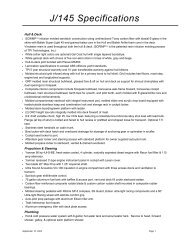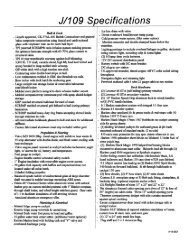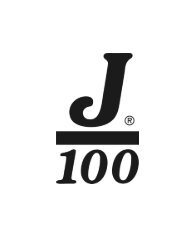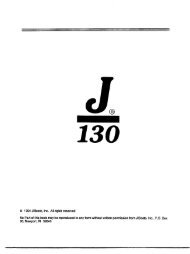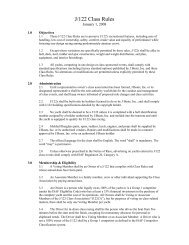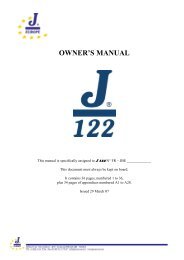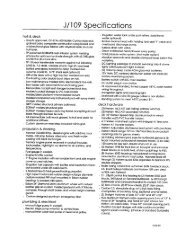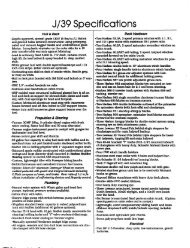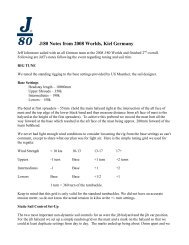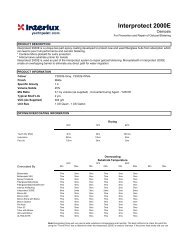J105 Owner Manual 2012.pdf - J/Owners
J105 Owner Manual 2012.pdf - J/Owners
J105 Owner Manual 2012.pdf - J/Owners
You also want an ePaper? Increase the reach of your titles
YUMPU automatically turns print PDFs into web optimized ePapers that Google loves.
J/105 <strong>Owner</strong> Guide ...................................................................................................................................................................................................................................................... 11 <br />
Mast -‐ Rigging the J/105 mast is a common procedure, and best handled by a qualified marine <br />
rigger. All spreaders, shrouds, and halyards are installed and properly taped and secured. Be sure <br />
all mast related electronics and wind indicators are properly wired and installed prior to <br />
stepping the mast. After stepping the mast it is VERY IMPORTANT to properly brace the mast <br />
within the mast collar PRIOR to sailing with the provided Pre-‐Molded Spartite mast wedge. We <br />
also recommend that a small cord is tied and taped approx. 24” above the lower spreader <br />
between the intermediate shroud and upper shroud if you plan to sail with any type of spinnaker. <br />
Simply tie this line to each shroud (allowing for some slack) and tape ends over with rigging tape. <br />
This prevents the spinnaker (during a take-‐down) from potentially dropping into the V that is <br />
formed at the lower spreader between these shrouds. <br />
Hydraulic Backstay -‐ The J/105 is equipped with an integral hydraulic backstay to help you fine <br />
tune your rig and sails for optimum performance. This hydraulic unit is simple to operate, easy <br />
to maintain, and highly reliable. The cylinder is affixed to the backstay tang on the transom and <br />
to the backstay. In order to attach the backstay, you must pull out the SS shaft and fully extend it. <br />
Boom -‐ Run the reef lines so the red line (port) is led through the port sheaves and the green line <br />
(starboard) is led through the starboard sheaves at both the outboard end and the gooseneck. <br />
The starboard reef doubles as the cunningham. <br />
Boom Vang -‐ The standard boom vang is a mechanically operated spring loaded boom vang with a <br />
block and tackle purchase system. This vang system allows for quick and easy adjustment and <br />
also acts as a boom topping lift. The vang is affixed to the vang plate welded underneath the <br />
boom and to the mast at the vang gooseneck located just above the mast collar. See the vang <br />
operating instructions for how to adjust the internal spring for best results. <br />
Sail Control Systems <br />
After stepping the mast and connecting the boom, vang, roller-‐furler, and integral backstay, rig all <br />
halyards and the remaining sail control systems on deck. <br />
Main Halyard -‐ exits the mast on the port side, runs through a turning block at the mast collar, <br />
through the inboard port organizer block and then aft through the port double stopper (inboard <br />
hole) and finally to the halyard winch. The tail end is stored in the supplied line bag to be <br />
mounted outboard and forward of the stopper. <br />
Jib Halyard -‐ exits the mast to port, leads through the forward mast base block, aft to the outboard <br />
sheave on the organizer block, through the outboard stopper hole, and store tail in line bag. <br />
Spinnaker Halyard -‐ exits the mast to starboard and leads to the outboard sheave and stopper. <br />
Mainsheet Traveler -‐ is a Harken low friction system. The 3:1 purchase system on each side <br />
controls a Harken Windward Sheeting Car mounted on midrange track (see diagram). <br />
Outhaul -‐ is adjusted at the cleat on the underside of the boom and comes pre-‐assembled. <br />
Cunningham -‐ The cunningham doubles as the starboard reef line. To set it up as a cunningham <br />
simply tie a knot at the boom end tail of the reef line. The line leads forward to the sheave at the <br />
gooseneck, up to the cunningham block/hook back down through a bullseye on the mast, down <br />
to the mast base block and aft to the inboard stopper.(see diagram). To use the continuous reef



